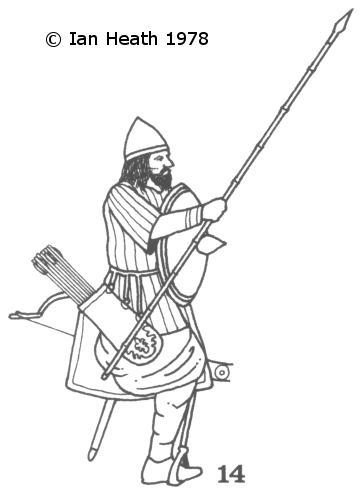TURCOPOLE
An extract from Armies and Enemies of the Crusades 1096-1291by Ian Heath


14. TURCOPOLE
Turcopoles were Syrian mercenaries employed in considerable numbers by the Military Orders as well as by the king and Frankish nobility.
Despite the statements of R. C. Smail in his ‘Crusading Warfare’ that ‘there seems little justification in assuming, on the basis of the scanty information usually quoted, that all Turcopoles were both horsemen and archers’ and, of horse-archery, ‘that there is no reason to suppose that many natives of Syria were adept in its use’, it seems fairly certain that the Turcopoles were all horsemen and that although not all were necessarily armed with a bow by far the majority were. Those at Sarmin in 1115 were certainly archers, and Usamah ibn-Munqidh actually calls the Turcopoles ‘the archers of the Franks’; in addition a chronicler of the Third Crusade, describing an engagement with Byzantine troops on Cyprus, wrote ‘like a swift Turcopole did the Emperor ride . . . and shot 2 arrows at the king.’ Further evidence that they were mounted may be inferred from the wording of Moslem treaties, such as those of 1267, 1269 and 1283, all of which equate ‘a knight for a knight, a Turcopole for a Turcopole, a merchant for a merchant, a foot-soldier for a foot-soldier’. Saladin, dictating terms for the surrender of Jaffa in 1192, likewise equated knight for horseman, foot-soldier for foot-soldier and Turcopole for light-armed soldier; in all these instances the very specific ‘foot-soldier for foot-soldier’ clearly excludes the Turcopoles, by which we may take it they were mounted. William of Tyre states quite specifically that they were ‘light-armed horsemen’.
At first they were probably mainly half-breeds, Syrian natives and Turkish converts, but later they included a great many Poulain sergeants who were probably equipped to fight Saracen-fashion, Dr. J. Riley-Smith suggesting that by the 13th century the term Turcopole ‘referred to the function rather than the race of the holder’.
In addition to the bow the Turcopoles would have carried a light lance and/or javelins plus a sword and possibly a mace. Whether they were armoured or not is a moot point. As already seen, William of Tyre and Saladin both described them as ‘light-armed’, but that is also the standard contemporary description of Saracens, many of whom wore light or not-so-light armour. The fact that Turcopoles were often mustered alongside the knights would tend to suggest that they wore light armour of some description, even if only quilted al-Qutuns, and it is interesting to note that when Guy de Lusignan first established fiefs in Cyprus in 1192 those of Turcopoles owed the service of a man with mail armour (as well as 2 horses).
It seems probable that those employed by the Military Orders would have carried some kind of recognition device, probably a cross (of the appropriate colour) on shield and/or tunic. (Confrere brethren and mercenaries of the Orders probably carried similar devices; we hear, for instance, of shields with chief gules a cross argent, indicating allegiance to the Hospitallers.)